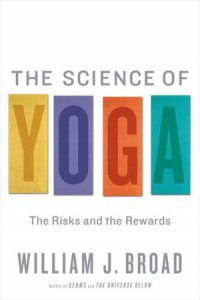My primary new year’s resolution for 2014 is “do more yoga.” Periodically over the last decade, I’ve done a fair amount of yoga, primary Ashtanga, which is one of the more athletic forms of yoga, usually done in heated room, and (to oversimplify) keeps a flow by inserting sun salutations in between poses. Part of why I’m drawn to yoga is that it is a both a meditative exercise and an embodied spirituality that gets me out of my head. It is also a great counterbalance to my running routine.
 Over the holidays, as preparation for an increase in my commitment to yoga, I read William Broad’s excellent book The Science of Yoga: The Risks and the Rewards. Broad,
Over the holidays, as preparation for an increase in my commitment to yoga, I read William Broad’s excellent book The Science of Yoga: The Risks and the Rewards. Broad,
has practiced yoga since 1970. A bestselling author and senior writer at The New York Times, he has won every major award in print and television during more than thirty years as a science journalist. With New York Times colleagues, he has twice won the Pulitzer Prize, as well as an Emmy and a DuPont. He is the author or coauthor of seven books.
I discovered his yoga book through three related articles he published in The New York Times over the past year or so: “How Yoga Can Wreck Your Body,” “Wounded Warrior Pose: The Perils of Yoga for Men,” and “Women’s Flexibility Is a Liability (in Yoga).” Don’t get the wrong idea from the headlines. He (as well as myself) are big fans of yoga. The lesson is simply to proceed slowly and with caution.
My biggest takeaway from the book is that I no longer have any aspirations to advanced yoga practice — of being able to fully contort my body into some of the extreme poses I have seen some yoga instructors do. After all, regarding Hatha Yoga (the basis of yoga as we know it today) “The Sanskrit root of Hatha is hath — ‘to treat with violence,’ presumably in reference to the intensity that is necessary for the most advanced poses (17). I’m content with the many benefits and much less risk of intermediate practice. And Broad’s Chapter Four on “Risk of Injury” is clear that yogis are well advised to be protective especially of their backs and necks.
I’m also clear from reading the book that yoga is wonderful in many way, but it is not a replacement for cardio:
scientists concluded that the yoga session failed to meet minimal aerobic recommendations of the world’s health bodies. Its oxygen demands, they reported, “represent low levels of physical activity similar to walking on the treadmill at a slow pace or taking a leisurely stroll….” Decades of uncertainty ended as a consensus emerged that yoga did much for the body and mind but little or nothing for aerobic conditioning. (72)
That being said, yoga also
equaled or surpassed exercise in such things as improving balance, reducing fatigue, decreasing anxiety, cutting stress, lifting moods, improving sleep, reducing pain, lowering cholesterol, and more generally in raising the quality of life for yogis, both socially and on the job. (72-3)
I went to my first yoga class of the new year this morning, and loved it. Whatever your resolutions, may this new year be a good one for you and yours.
The Rev. Dr. Carl Gregg is a trained spiritual director, a D.Min. graduate of San Francisco Theological Seminary, and the minister of the Unitarian Universalist Congregation of Frederick, Maryland. Follow him on Facebook (facebook.com/carlgregg) and Twitter (@carlgregg).
Learn more about Unitarian Universalism:
http://www.uua.org/beliefs/principles












